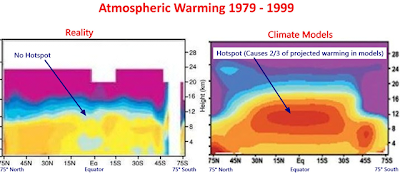Dr. David Evans of Australia has written what amounts to a primer for non-scientists on the failure of warmie computer modeling. Warmie models are all predicated on the basic assumption that as CO2 increases, temperatures will increase. More specifically, it is not just the increasing CO2, but how other natural systems of our earth - referred to in the warmie world as "feedbacks" - react to the increasing CO2 in the atmosphere that are supposed to cause the warming. The warmies make these feedbacks a threefold multiplier in attempting to project global warming. As Dr. Evan's explains:
Feedbacks are due to the ways the Earth reacts to the direct warming effect of the CO2. The threefold amplification by feedbacks is based on the assumption, or guess, made around 1980, that more warming due to CO2 will cause more evaporation from the oceans and that this extra water vapor will in turn lead to even more heat trapping because water vapor is the main greenhouse gas. And extra heat will cause even more evaporation, and so on. This amplification is built into all the climate models. The amount of amplification is estimated by assuming that nearly all the industrial-age warming is due to our CO2.
So, how have the warmie models held up against the data? For full and detailed explanations, see Dr. Evan's post. But the quick down and dirty from the graphs:
1. Jim Hansen's 1998 Projections
2. IPCC 1990 Computer Model Projections
3. ARGO Sea Temperature Data vs. Models
4, Atmospheric "Hot Spot"
This one requires a little explanation. If the warmie models were accurate, data should show a hot spot in mid to upper atmosphere centered over the equator.
5. Outgoing radiation versus ocean temperatures.
This is another one that requires some explaination:
The top left graph shows what has actually happened - as oceans warm, more heat is radiated into space. All of the rest of the graphs are from climate models. As you can tell from the slope, they each project that the opposite will occur, that as ocean temperatures increase, more of the heat will be trapped on earth and less radiated into space.
As Dr. Evan's concludes:
The climate models get them all wrong. The missing hotspot and outgoing radiation data both, independently, prove that the amplification in the climate models is not present. Without the amplification, the climate model temperature predictions would be cut by at least two thirds, which would explain why they overestimated the recent air and ocean temperature increases.
Therefore:
1. The climate models are fundamentally flawed. Their assumed threefold amplification by feedbacks does not in fact exist.
2. The climate models overestimate temperature rises due to CO2 by at least a factor of three.
The skeptical view is compatible with the data.
Tweet






















































No comments:
Post a Comment